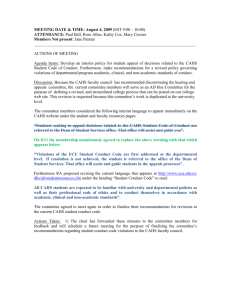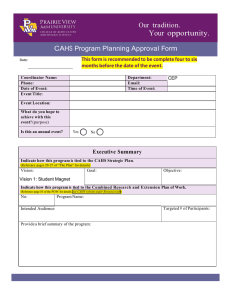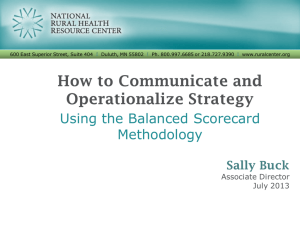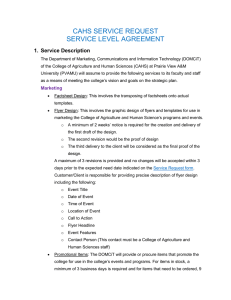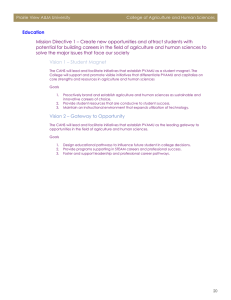College of Allied Health Sciences
advertisement
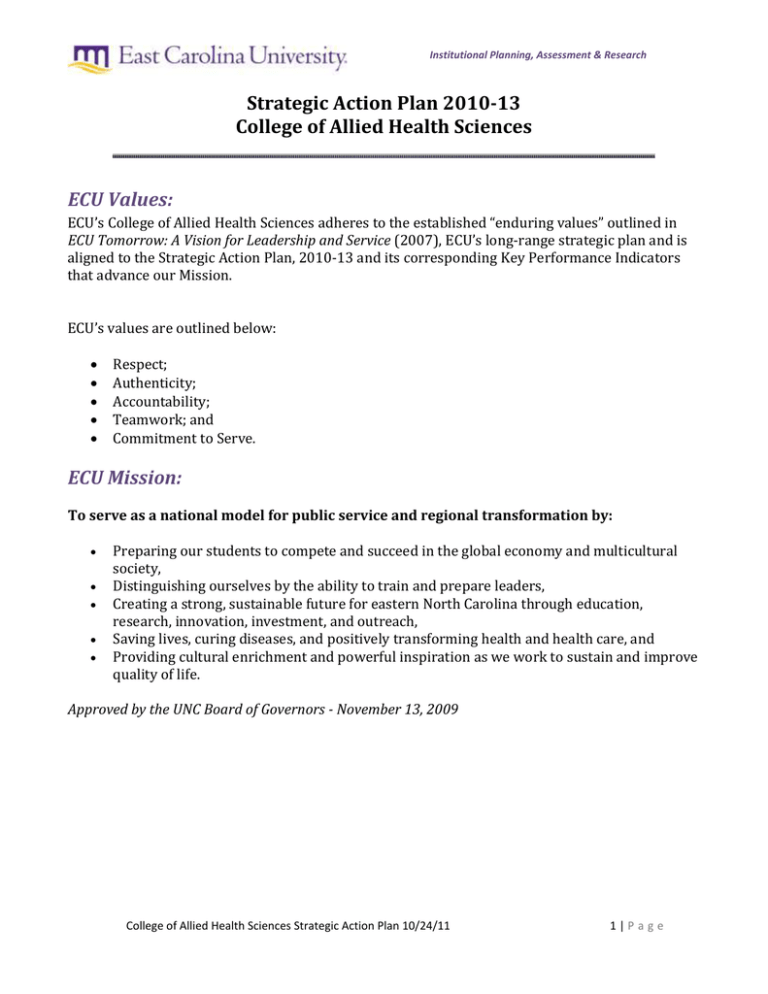
Institutional Planning, Assessment & Research Strategic Action Plan 2010-13 College of Allied Health Sciences ECU Values: ECU’s College of Allied Health Sciences adheres to the established “enduring values” outlined in ECU Tomorrow: A Vision for Leadership and Service (2007), ECU’s long-range strategic plan and is aligned to the Strategic Action Plan, 2010-13 and its corresponding Key Performance Indicators that advance our Mission. ECU’s values are outlined below: Respect; Authenticity; Accountability; Teamwork; and Commitment to Serve. ECU Mission: To serve as a national model for public service and regional transformation by: Preparing our students to compete and succeed in the global economy and multicultural society, Distinguishing ourselves by the ability to train and prepare leaders, Creating a strong, sustainable future for eastern North Carolina through education, research, innovation, investment, and outreach, Saving lives, curing diseases, and positively transforming health and health care, and Providing cultural enrichment and powerful inspiration as we work to sustain and improve quality of life. Approved by the UNC Board of Governors - November 13, 2009 College of Allied Health Sciences Strategic Action Plan 10/24/11 1|P a g e Institutional Planning, Assessment & Research Key Strategic Planning Principles: Several key planning principles were established to develop this strategic plan: Support for student success throughout the continuum of their college learning experience; Adherence to ECU Tomorrow: A Vision for Leadership and Service, 2007 and the ECU Strategic Action Plan, 2010-13; Support for effective leadership and professional development; Purposeful decision-making, moving towards clearly defined goals and measurable objectives; A commitment to institutional effectiveness; and, Allocation of resources to ensure attainment of established priorities. Goals: GOAL 1: GOAL 2: GOAL 3: GOAL 4: GOAL 5: GOAL 6: GOAL 7: GOAL 8: GOAL 9: GOAL 10: GOAL 11: GOAL 12: GOAL13: GOAL14: GOAL 15: GOAL 16: GOAL 17: GOAL 18: GOAL 19: Provide learning opportunities that prepare our faculty and students for a rapidly changing global society. Create and sustain a supportive climate for diversity in CAHS. Increase efforts to support the university's commitment to diversity and inclusion. Recruit and retain a diverse CAHS student, faculty and staff community. Engage in community and service activities that expose students and faculty to diverse populations and their unique health care needs. Graduate a health care workforce that is prepared to use the latest technology relevant to the health industries. Graduate students who use excellent clinical reasoning skills to make informed decisions. Promote CAHS student participation in research as an integral part of academic training. Provide robust graduate training programs that parallel and support our highest research priorities. Enhance faculty and student research productivity. Enhance the success of Allied Health students by maintaining curricula grounded in disciplinary standards. Promote CAHS student leadership. Increase awareness of and support for excellence in student leadership. Strengthen the research culture in CAHS. Create common themes for research clusters that combine broad-based approaches in basic, translational, clinical and community-based research. Define evidence-based strategies in CAHS disciplines. Develop, lead and collaborate on research programs centered around high-priority themes. Increase efforts to integrate health promotion and therapeutic interventions. Explore VA service contracts and student clinical service contracts with the Veteran’s Administration Clinic to be built in Greenville. College of Allied Health Sciences Strategic Action Plan 10/24/11 2|P a g e Institutional Planning, Assessment & Research GOAL 20: GOAL 21: GOAL 22: GOAL 23: GOAL 24: GOAL 25: Benchmark the ideal student outcomes within each degree granting departments to appropriate sources. Increase opportunities for students interested in doctoral work in the rehab sciences. Increase the inter-professional learning opportunities for CAHS students. Aggressively pursue external funding for workforce development projects relevant to our programs and priorities. Recognize faculty innovations through the tenure, promotion and merit process Support of a culture of collaboration between CAHS and hospitals and other corporate entities. College of Allied Health Sciences Strategic Action Plan 10/24/11 3|P a g e Institutional Planning, Assessment & Research Goal 1: Provide learning opportunities that prepare our faculty and students for a rapidly changing global society. Outcome Objective: Enhance curricula within CAHS degree granting programs to increase the number of student assignments related to global awareness. Measure: By 2011, 5 of the 7 CAHS degree granting programs will include one assignment/presentation in one course intended to enhance students’ global awareness. Documentation within the annual report from Department Chairs with supporting data listing course/assignment Goal 2: Create and sustain a supportive climate for diversity in CAHS. Outcome Objective: Increases access to diversity related resources and knowledge that support course content and student learning through the development of a diversity toolkit. Measure: By spring of 2012 the Diversity Committee will prepare a diversity toolkit with representative activities provided by CAHS faculty. By spring of 2013, 80% of CAHS departments will report use of the toolkit by 2012/2013 Outcome Objective: Insure that CAHS degree granting programs address the requirements of their professional accrediting bodies regarding diversity issues and cultural competence. Measure: By 2011 100% of degree granting programs in CAHS will annually update the document listing the accreditation standards regarding diversity and cultural competence maintained by the Dean's office Goal 3: Increase efforts to support the university's commitment to diversity and inclusion. Outcome Objective: Increase participation of diverse students in the CAHS by providing student scholarships. Measure: By 2011 the CAHS will establish 2 student scholarships per degree granting department for the Mills Symposium Measure: By 2012/2013 in collaboration with the Medical and Health Sciences Foundation CAHS will establish 1 CAHS scholarship for underrepresented students that would be open to any full-time CAHS student Outcome Objective: Maintain an ongoing collaborative relationship with the Office of Institutional Diversity. Measure: Annually the CAHS will continue active membership on 1 or more of the OID ECU committees College of Allied Health Sciences Strategic Action Plan 10/24/11 4|P a g e Institutional Planning, Assessment & Research Outcome Objective: Increase awareness of the ECU community regarding CAHS diversity initiatives. Measure: Increase reporting by 20% of CAHS diversity related events through newsletters, emails, TV monitors in public areas, dean's reports to faculty and BOT Goal 4: Recruit and retain a diverse CAHS student, faculty and staff community. Outcome Objective: Increase the number of faculty from under represented populations Measure: 20% of the applicant pool of qualified faculty will be underrepresented groups for open positions Outcome Objective: Reduce the barriers and facilitators to accepting and retaining a diverse student body. Measure: Increase by 5% the number of CAHS students from underrepresented groups by spring 2013 Outcome Objective: Continue attendance of CAHS marketing and admissions staff person at recruitment events where underrepresented students are present. Measure: Annually the CAHS marketing staff person will list the dates of marketing school/events attended for at least 4 HBCU and 1 other recruitment event where underrepresented student populations are featured Goal 5: Engage in community and service activities that expose students and faculty to diverse populations and their unique health care needs. Outcome Objective: Engage in community and service activities that expose students and faculty to diverse populations and their unique health care needs. Measure: By spring of 2011 each CAHS degree department will place 5 students annually in clinical field experiences in rural areas in eastern North Carolina each year Outcome Objective: Increase awareness of the Jean Mills Health Symposium by the ECU and external community. Measure: By spring of 2013 CAHS will increase by 25% the distribution of Mills marketing materials to internal and external community members College of Allied Health Sciences Strategic Action Plan 10/24/11 5|P a g e Institutional Planning, Assessment & Research Goal 6: Graduate a health care workforce that is prepared to use the latest technology relevant to the health industries. Outcome Objective: Increase the inclusion of health technology such as electronic health records, electronic documentation software, PDAs, into CAHS curricula. Measure: By 2012 at least 1 ours syllabi in each degree granting department will include objectives relating to health technology Measure: By 2013 each department will include dedicated software in department labs Goal 7: Graduate students who use excellent clinical reasoning skills to make informed decisions. Outcome Objective: Enhance CAHS departmental curricula to focus on critical thinking in clinical situations. Measure: By spring of 2013 every CAHS degree granting department, will include one clinical decision making assignment or activity in one course Goal 8: Promote CAHS student participation in research as an integral part of academic training. Outcome Objective: Increase internal and external funding for graduate and undergraduate student participation in research through the Research Scholars (PhD) and Clinical Research Scholars (DPT and MS) Program and other grant-supported mechanisms. Measure: Annual Report of the Associate Dean for Research with supporting data such as a listing of MS and PhD Theses/Dissertations; student co-authorship on faculty publications; student external grant submissions and award; faculty grants and GCRT accounts that include student financial support Goal 9: Provide robust graduate training programs that parallel and support our highest research priorities. Outcome Objective: Increase PhD students in the Rehabilitation Scientists by expanding the funding and enrollment of students in the existing PhD Programs in order to support Operation Reentry North Carolina. Measure: By spring of 2013, increase by 10% the number of PhD students in this PhD program who are dedicated to work on the faculty projects related to ORNC College of Allied Health Sciences Strategic Action Plan 10/24/11 6|P a g e Institutional Planning, Assessment & Research Goal 10: Enhance faculty and student research productivity. Outcome Objective: Where appropriate, provide sufficient protected research time for existing faculty and startup funds for new faculty to ensure that faculty members can be productive and competitive for external grant funding. Measure: By spring of 2013, increase by 20% CAHS faculty and student research grant applications Measure: Calculate the amount and increase of startup funds for identified new faculty. And/or protected time for existing faculty Goal 11: Enhance the success of Allied Health students by maintaining curricula grounded in disciplinary standards. Outcome Objective: Continue to meet and exceed the mean pass rates of national exams within all degree granting departments whose professions use a national exam. Measure: Annually count the number of CAHS degree granting departments that meet or exceed the mean pass rate on their national exam Outcome Objective: Assess student skill and application through evaluation of student performance in clinical sites, where appropriate, and revise curriculum and field. experiences to improve and/or maintain (above average supervisor clinical ratings) Measure: Annual description of curricular changes and supervisor ratings provided by Department Chairs unit annual reports Goal 12: Promote CAHS student leadership. Outcome Objective: Increase CAHS student access to leadership opportunities. Measure: By spring 2012 increase by 20% the number of leadership activities offered in CAHS student organizations as reported by the faculty advisors to the student organizations Outcome Objective: Offer courses that address leadership within 5//7 degree granting programs. Measure: Annually count the number of courses per degree granting departments that include at least one leadership activity or assignment Outcome Objective: Maintain a CAHS Leadership Collaborative that advises the Dean’s office on matters related to student leadership development. Measure: Annually evaluate CAHS student leadership development initiatives and construct recommendations for improvement College of Allied Health Sciences Strategic Action Plan 10/24/11 7|P a g e Institutional Planning, Assessment & Research Outcome Objective: Use leadership artifacts and language that convey the value of leadership development in allied health. Measure: By spring 2011, 100% of CAHS and degree granting department websites will include the language used in the ECU Leadership Framework Goal13: Increase awareness of and support for excellence in student leadership. Outcome Objective: Recognize CAHS students who excel in leadership. Measure: By spring 2012, develop and implement a CAHS student leader award Goal14: Strengthen the research culture in CAHS. Outcome Objective: Increase the number of federal research grant submissions and award rates within targeted areas (rehabilitation, health disparities, rural community health, technology, telemedicine, diabetes, obesity, CV, health informatics, agromedicine, behavioral health, military). Measure: By spring 2013 increase federal grant submission rate by 25% and award rate by 10% Goal 15: Create common themes for research clusters that combine broad-based approaches in basic, translational, clinical and community-based research. Outcome Objective: Develop a CAHS research collaborative under the direction of the Associate Dean for Research. Measure: By spring 2012, document 2 meetings of the collaborative and a list of identified themes Goal 16: Define evidence-based strategies in CAHS disciplines. Outcome Objective: Lead in the development of clinical trials for disciplines within allied health. Measure: By spring of 2013, engage in one funded clinical trial College of Allied Health Sciences Strategic Action Plan 10/24/11 8|P a g e Institutional Planning, Assessment & Research Goal 17: Develop, lead and collaborate on research programs centered around highpriority themes. Outcome Objective: Promote and invest in projects that translate basic discoveries into clinical and community applications around the themes identified through the Research Collaborative above. Measure: By 2013 CAHS faculty will annually submit 1 external grant focused on one or more of the themes identified in 3.1.2 Goal 18: Increase efforts to integrate health promotion and therapeutic interventions. Outcome Objective: Support and expand on collaborative efforts such as the Pediatric Healthy Weight Clinic, Falls Clinic in the ED, Digital Health Records for self-management of chronic disease. Measure: Evidence of 3 new or ongoing collaborative efforts annually Goal 19: Benchmark the ideal student outcomes within each degree granting departments to appropriate sources. Outcome Objective: Compare CAHS degree programs to curriculum requirements defined by their respective accreditation bodies and appropriately change courses or curricula. Measure: Annual reaccreditation maintenance reports and/or accreditation reports Goal 20: Increase opportunities for students interested in doctoral work in the rehab sciences. Outcome Objective: Link doctoral research training programs with interdisciplinary research programs like Operation Reentry NC. Measure: By spring of 2013, increase students initiating interdisciplinary rehabilitation research by 20% Goal 21: Increase the inter-professional learning opportunities for CAHS students. Outcome Objective: Increase the use of course or modular teaching/simulation for interprofessional collaborations. Measure: Annually increase student based inter-professional research projects by one within CAHS College of Allied Health Sciences Strategic Action Plan 10/24/11 9|P a g e Institutional Planning, Assessment & Research Outcome Objective: Develop co-curricular learning opportunities focused on interprofessional skill development through partnerships between ECU and PCMH. Measure: Annually implement 2 inter-professional learning opportunities for CAHS students Outcome Objective: Increase involvement of all CAHS departments in interdisciplinary or inter-professional research projects. Measure: Annually, a minimum of 4 faculty member four of the CAHS departments will participate in inter-professional research Goal 22: Aggressively pursue external funding for workforce development projects relevant to our programs and priorities. Outcome Objective: Increase research infrastructure to include workforce development initiatives. Measure: By spring of 2013, hire one person whose job description focuses on workforce development Goal 23: Recognize faculty innovations through the tenure, promotion and merit process. Outcome Objective: Review department tenure and promotion criteria to ensure that engagement, innovation and entrepreneurship are explicitly included in such decisions. Measure: Annually, track revisions to department tenure and promotion criteria regarding the value of engagement, innovation and entrepreneurship in the tenure/promotion process Goal 24: Support of a culture of collaboration between CAHS and hospitals and other corporate entities. Outcome Objective: Participate in the Allied Health Research Institute as a means for fostering public-private partnerships with hospitals and other corporate entities. Measure: Annually record membership and participation in AHRI meetings College of Allied Health Sciences Strategic Action Plan 10/24/11 10 | P a g e
